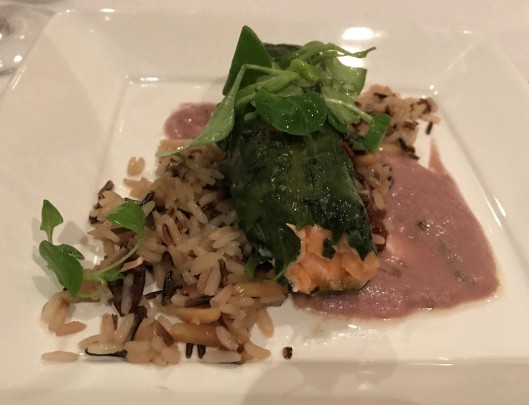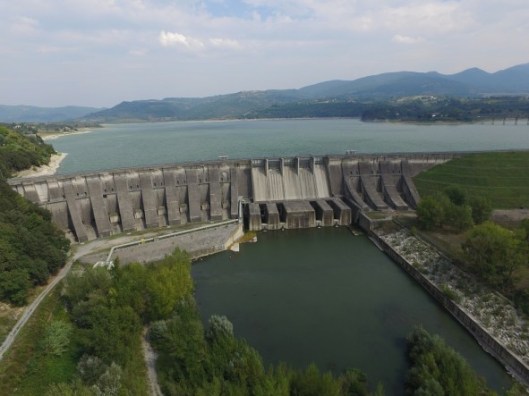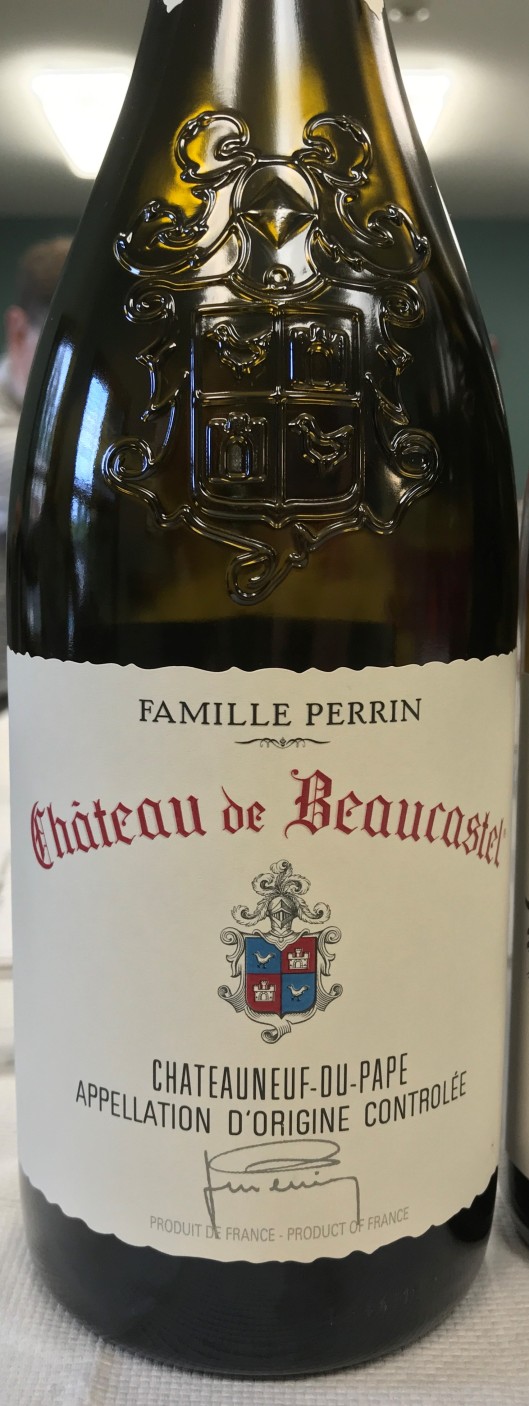I recently had the pleasure of enjoying a wonderful wine dinner at Legal Sea Foods, Park Square. The dinner was memorable for many reasons. First, I was able to reconnect with an old friend, who is one of the key influencers of my wine journey, Sandy Block, MW. Second, I was able to taste some great wines from Santa Inez, from a west coast winery that does it right and is hard to find on this side of the map. And lastly, I was able to experience the amazing Food and Beverage program at Legal Seafoods and meet our absolutely gracious and amazing host, Bryn Burke.
Sandy Block, MW is an icon, not only in the Boston area, but in the world of wine. I have been remarkably fortunate to have met some of this area’s wine luminaries over the years and more importantly, I have had the opportunity to taste and discuss wine with them, at length. The experience has been immeasurably important to my personal development as a wine educator. Enjoying this evening with Sandy was truly something special. Sandy is the consummate gentleman. Soft spoken, laid back and completely unassuming, making you feel right at home. His keen observations and deep knowledge provide the proper balance between sybaritic enjoyment and educational awareness.
If I look at the program that Sandy has created at Legal Seafoods, it is a model of exactly how the hospitality industry, specifically restaurants should approach wine (and spirits). First, concentrate on staff education. It is proven that a restaurant will sell more wine when the staff are properly educated and can provide trusted input towards a patron’s wine choices. Legal Seafoods invest significant effort into training staff so that they know and understand wine as an integral part of the dining experience. Second, create a wine list that is interesting with great value, appealing to a wide range of diners from novice to expert. A wine list should have enough diversity, with the usual “suspects,” peppered with eclectic bottles from far-flung regions to give choice without being overwhelming. Lastly, offering fun wine dinner experiences is critical to program success. Such dinners allow consumers contact with the wine makers without having to travel to far-away regions, which for wine enthusiasts is like meeting their favorite Hollywood movie stars. Wine dinners also provide a vehicle whereby the importance of wine and food pairing is showcased.
The dinner in question was the Beckmen Vineyards Winemaker Dinner, with Jeff Beckmen, the current proprietor. This was the first time attending a Legal Sea Foods wine dinner and I have to say, the experience was truly amazing. Upon arrival, we were ushered downstairs into the basement dining area and offered as a greeting wine, a glass of the Beckmen Vineyards Sauvignon Blanc. I will preface my remarks by saying that it is very rare that I find California Sauvignon Blanc that is true to type, or very interesting. The Beckmen was a delightful surprise. The wine had a perfumed nose of grapefruit and fresh mown grass with hints of honeysuckle and orange blossom – quite attractive. The palate was well-balanced with crisp acidity and clean, refreshing aftertaste. More grapefruit on the palate with notes of citrus and papaya. Showing beautifully, the wine was a perfect way to kick off the evening!
The dinner consisted of six courses, each paired with on or more Beckman wines. Once we were seated, our taste buds were tantalized by a mix of Hors D’oeuvres, including Baby Octopus Pintxo, Scallop Crudo, and Crabmeat-stuffed Shrimp was served. A wonderful mélange of flavors and textures that made an ideal accompaniment to the Beckmen Sauvignon Blanc.

The first entrée was a Spinach-wrapped Ora King Salmon with Wild Rice and Tarragon Beurre Rouge. Paired with the Salmon was the 2017 Beckmen Cuvee le Bec, a charming, fruit-forward blend of Syrah, Grenache, Mourvedre and Counois. One doesn’t instinctively think of pairing red with fish, but I was shown early in my career that medium-bodied, fruit-forward reds can pair well with certain fish, Salmon being one. The wine was all fruit in the nose with loads of black cherry and red currant. Well-balanced with moderate acidity and firm, well integrated tannin. A lush palate with more cherry, resolving with a spicy, herbaceous finish. Truly charming and a perfect mate to the fleshy, earthy tones of the Salmon and Tarragon. Heaven and we were only at the first stop of the journey.

Next up was a Toasted Sesame-Crusted Tuna and Nori Roll, with Fermented Kelp and Sesame Chili Vinaigrette, paired with the 2017 Beckmen Grenache. Another red wine with fish paring that worked perfectly because of the savory flavors found in the sesame and fermented kelp. The chili tang created magical synergy with the spicy-sweet quality of the Grenache. The nose of the wine was somewhat tight with bright, red fruits and a very light floral perfume of violets. Well-balanced with a dark fruit core, moderate acid and firm, intense tannin – Massive is the word that comes to mind. A long, almost sweet aftertaste softened the blow of the tannin. Ordinarily, pairing a wine with this tannic strength with fish is a recipe for disaster, but in this case, the flavors matched very well and created a complementary blend of sweet and savory. Well done!
The main course was a Panko-Crusted Lamb Chop with Roasted Fingerling Potatoes and Sautéed Provençal Vegetables, paired with two Beckmen wines, both from Purisima Mountain and both Syrah – one, the 2014 and the other, the 2017. If the food and wine to this point were truly amazing, the perfectly cooked lamb chop was absolutely sublime. The perfect degree of doneness showcased the tender, succulent nature of the meat. Mild without any gaminess, the flavor of the crust wove delicate streams of earthy, nutty goodness through the dish.
The two wines could not have been any more different, despite coming from the same vineyard and following a similar wine-making regimen. The two wines highlighted the importance of climate in this part of California, which, according to the pioneer of this region, Richard Sanford, are the reasons why California Central Coast wines are, and I second his opinion, the best the state as to offer. The 2014 Beckmen was a masterpiece. Dark fruit on the nose, earthy with concentrated black cherry and tar hints, mixed with delicate cedar and spice. Well-balanced with moderate acidity and firm, well-integrated tannin. Dark fruit with chocolate and cocoa dust on the palate. Tight finish. This wine is a sleeping monster, largely due to heavily reduced yields (only 80% of normal) as a result of droughts during the spring and growing season.
The 2017 Beckmen showed similar lineage, but the wine was much more overtly expressive. A jammy fruit-driven nose with allspice and blackberry jam hints leads the way. Good balance, not as well integrated as the 2014. Bright and fruity on the palate – ripe berries and just a hint of eucalyptus. My imperfect prediction is that the 2017 is not the massive wine that is the 2014, and as a result may not age as long or as gracefully. Jeff Beckmen, a man who obviously has much more experience with aging his wines, politely disagrees and sees as much potential in the 2017 as was shown on the 2014. It matters not – the wine and food pairing was again, heavenly!
We next had a wonderful cheese course of Brillat-Savarin, Montrachet and Morbier, with Mission Figs, Jamon Serrano and Toasted Almonds, paired with the 2016 Beckmen Cabernet Sauvignon. The cheese was perfectly ripe and was the ideal way of finishing the meal. Anything sweeter would have pushed the limit on one’s appetite.

The principle vineyards owned by Beckmen are in the western portion of the region in what is called the Ballard Canyon, where the mountain valley vineyards benefit from the broad diurnal pattern of Santa Ynez climate. The soil, highly limestone and clay, also shares many similarities to the Rhone Valley, where the varieties of Syrah, Grenache, Mourvedre and Counois are made into historically significant wines. It may be that Ballard Canyon will share in some of this notoriety that the Rhone Valley enjoys. I suspect that the positive press received by Beckmen wines hints as such.
The Cabernet grapes that went into the 2016 were NOT from Ballard Canyon… Not surprised because the climate that grows great Rhone varietals is NOT the climate that grows great Cabernet. This wine is sourced from grapes further east in Los Olivos, another favorite region that I tripped over nearly 20 years ago!
The 2016 shows an earthy nose with menthol, eucalyptus, tobacco leaf and brambles. Cherry aromas wove within the “terroir-like” bouquet and gave the wine a lightly fruity character. Well-balanced with moderate acidity and well-integrated tannin creates a lush mid-palate loaded with bright red cherry and red currant. I bought several bottles of the wine because I want to see how it evolves with some bottle age – you should too!
I can’t offer any higher recommendation for the Legal Sea Foods wine dinner series than to insist that you find a way to attend a dinner soon. The dinners are offered at both the Park Square and Long Wharf Waterfront locations – if you have not done so, visit https://www.legalseafoods.com/ and sign up for their special events newsletter. As someone who has been enjoying fine wine and food for over thirty-five years, the Legal Sea Food wine dinners are a throwback to the golden age of fine wine and food appreciation mid-1980’s Boston!
Also, I will be conducting an extensive wine tasting of Beckmen Vineyards wines – some from the wine dinner and others from the library of Jeff and his family. I am working out sourcing as I type. Follow me at: https://www.facebook.com/pg/MusingsontheVine/events/?ref=page_internal, my Facebook events page for more details and sign up details when the event becomes reality. Expect a June timeframe if all goes well.
— Cheers!









































